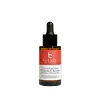What's inside
What's inside
 Key Ingredients
Key Ingredients

 Benefits
Benefits

 Concerns
Concerns

 Ingredients Side-by-side
Ingredients Side-by-side

Water
Skin ConditioningHamamelis Virginiana Water
AstringentCassia Angustifolia Seed Polysaccharide
Skin ConditioningGlycerin
HumectantAloe Barbadensis Leaf Juice
Skin ConditioningDimethyl Sulfone
SolventSodium Ascorbyl Phosphate
AntioxidantSnail Secretion Filtrate
Skin ConditioningCentella Asiatica Extract
CleansingSimmondsia Chinensis Seed Oil
EmollientTocopheryl Acetate
AntioxidantHydroxyethyl Ethylcellulose
EmulsifyingCarrageenan
Equisetum Arvense Extract
AstringentPelargonium Graveolens Oil
MaskingTaraxacum Officinale Extract
Skin ConditioningGeranium Maculatum Extract
TonicSodium Benzoate
MaskingPotassium Sorbate
PreservativeEthylhexylglycerin
Skin ConditioningWater, Hamamelis Virginiana Water, Cassia Angustifolia Seed Polysaccharide, Glycerin, Aloe Barbadensis Leaf Juice, Dimethyl Sulfone, Sodium Ascorbyl Phosphate, Snail Secretion Filtrate, Centella Asiatica Extract, Simmondsia Chinensis Seed Oil, Tocopheryl Acetate, Hydroxyethyl Ethylcellulose, Carrageenan, Equisetum Arvense Extract, Pelargonium Graveolens Oil, Taraxacum Officinale Extract, Geranium Maculatum Extract, Sodium Benzoate, Potassium Sorbate, Ethylhexylglycerin
Aloe Barbadensis Leaf Juice
Skin ConditioningGlycerin
HumectantAscorbic Acid
AntioxidantFerulic Acid
AntimicrobialHyaluronic Acid
HumectantThioctic Acid
AntioxidantMalus Domestica Fruit Cell Culture Extract
Skin ConditioningArgania Spinosa Kernel Oil
EmollientBrassica Oleracea Italica Seed Oil
EmollientSimmondsia Chinensis Seed Oil
EmollientVitis Vinifera Seed Extract
AntimicrobialCalendula Officinalis Flower Extract
MaskingSalix Alba Bark Extract
AstringentLeuconostoc/Radish Root Ferment Filtrate
AntimicrobialSunflower Seed Oil Glycerides
EmollientOleic Acid
EmollientSuperoxide Dismutase
AntioxidantXanthan Gum
EmulsifyingCyamopsis Tetragonoloba Gum
Emulsion StabilisingTocopherol
AntioxidantSodium Citrate
BufferingCitrus Sinensis Peel Oil Expressed
PerfumingAloe Barbadensis Leaf Juice, Glycerin, Ascorbic Acid, Ferulic Acid, Hyaluronic Acid, Thioctic Acid, Malus Domestica Fruit Cell Culture Extract, Argania Spinosa Kernel Oil, Brassica Oleracea Italica Seed Oil, Simmondsia Chinensis Seed Oil, Vitis Vinifera Seed Extract, Calendula Officinalis Flower Extract, Salix Alba Bark Extract, Leuconostoc/Radish Root Ferment Filtrate, Sunflower Seed Oil Glycerides, Oleic Acid, Superoxide Dismutase, Xanthan Gum, Cyamopsis Tetragonoloba Gum, Tocopherol, Sodium Citrate, Citrus Sinensis Peel Oil Expressed
Ingredients Explained
These ingredients are found in both products.
Ingredients higher up in an ingredient list are typically present in a larger amount.
Aloe Barbadensis Leaf Juice comes from leaves of the aloe plant. Aloe Barbadensis Leaf Juice is best known for helping to soothe sunburns. It is also anti-inflammatory, moisturizing, antiseptic, and can help heal wounds.
Aloe is packed with good stuff including Vitamins A, C, and E. These vitamins are antioxidants, which help fight free-radicals and the damage they may cause. Free-radicals are molecules that may damage your skin cells, such as pollution.
Aloe Barbadensis Leaf Juice also contains sugars. These sugars come in the form of monosaccharides and polysaccharides, folic acid, and choline. These sugars are able to help bind moisture to skin.
It also contains minerals such as calcium, 12 anthraquinones, fatty acids, amino acids, and Vitamin B12.
Learn more about Aloe Barbadensis Leaf JuiceGlycerin is already naturally found in your skin. It helps moisturize and protect your skin.
A study from 2016 found glycerin to be more effective as a humectant than AHAs and hyaluronic acid.
As a humectant, it helps the skin stay hydrated by pulling moisture to your skin. The low molecular weight of glycerin allows it to pull moisture into the deeper layers of your skin.
Hydrated skin improves your skin barrier; Your skin barrier helps protect against irritants and bacteria.
Glycerin has also been found to have antimicrobial and antiviral properties. Due to these properties, glycerin is often used in wound and burn treatments.
In cosmetics, glycerin is usually derived from plants such as soybean or palm. However, it can also be sourced from animals, such as tallow or animal fat.
This ingredient is organic, colorless, odorless, and non-toxic.
Glycerin is the name for this ingredient in American English. British English uses Glycerol/Glycerine.
Learn more about GlycerinThis oil comes from the seeds of the desert shrub called Jojoba. It is more commonly known as jojoba oil, a non-comedogenic oil.
Jojoba oil does not contain fragrance and has many fatty-acids, making it a great soothing ingredient.
It also contains Vitamin E, a great moisturizing ingredient. Vitamin E is also an antioxidant and protects your skin against oxidative damage.
This ingredient humectant properties, meaning it helps draw moisture from the air. This helps keep your skin hydrated.
While jojoba has antibacterial properties, it is only able to kill some strains of bacteria.
Studies also show it helps in wound healing. In fact, Indigenous cultures have used jojoba as a moisturizer and to help treat burns for centuries.
Fun fact: Jojoba oil similar to natural human skin sebum, so it has a great effect on dry skin. It is also promising with helping to regulate sebum production.
Due to its fatty acid content, Jojoba oil may not be fungal acne safe. We recommend speaking with a professional if you have any concerns.
Learn more about Simmondsia Chinensis Seed Oil